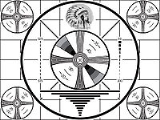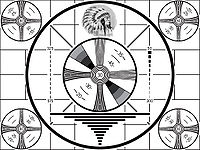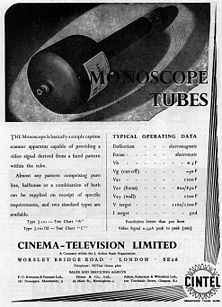
Monoscope
Encyclopedia



Cathode ray tube
The cathode ray tube is a vacuum tube containing an electron gun and a fluorescent screen used to view images. It has a means to accelerate and deflect the electron beam onto the fluorescent screen to create the images. The image may represent electrical waveforms , pictures , radar targets and...
that was used to generate, rather than display, a video signal. Each tube was only capable of generating a single video signal, hence the name. This kind of test card generation system was technologically obsolete by the 1980, but served many private and state broadcasters faithfully since its early use in the 1950s.
Design
Essentially similar in construction to an ordinary CRT, the monoscope contained a formed metal target in place of the phosphorPhosphor
A phosphor, most generally, is a substance that exhibits the phenomenon of luminescence. Somewhat confusingly, this includes both phosphorescent materials, which show a slow decay in brightness , and fluorescent materials, where the emission decay takes place over tens of nanoseconds...
coating at its "screen" end and as the electron beam scanned the target, a varying electrical signal was produced.
This signal reproduced an accurate image of the target and so could be used to produce test patterns and the like. For example, the classic Indian Head test card
Indian Head test card
The Indian Head Test Pattern was a black and white television test pattern which was introduced in 1939 by RCA of Harrison, New Jersey as a part of the RCA TK-1 Monoscope...
shown on the right was often produced using a monoscope.
Usage
Monoscope "cameras" were widely used to produce test cards, Station Logos, special signals for test purposes and of course announcements, like "normal service will be resumed....". They had many advantages over the use of a more expensive live camera, they were always ready, and were never misframed or out of focus.Pointing an electronic camera at the same stationary monochrome caption for a long period of time could result in the image becoming burnt onto the camera tube's target — and even onto the phosphor of a monitor displaying it in extreme cases.

See also
- Test cardTest cardA test card, also known as a test pattern in North America and Australia, is a television test signal, typically broadcast at times when the transmitter is active but no program is being broadcast...
, the updated, coloured version of monoscopes. - Images of test cards

